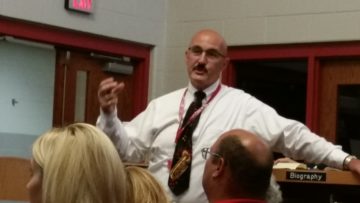By JAN LARSON McLAUGHLIN
BG Independent News
Bowling Green School District wants to hear from its residents. Do citizens want to renovate the existing buildings? Build new schools? Consolidate the three elementaries? And how much are they willing to support?
“We can kick the can down the road and ignore the issues,” Superintendent Francis Scruci said to a meeting of about 40 parents and teachers Tuesday evening. But the problems are only going to get more expensive to resolve, he warned.
Scruci said he will talk to any group about the options. He will meet with them anywhere they want – in offices, coffee shops or in neighborhood living rooms. The district is also conducting an anonymous survey on school facility and funding options. That survey can be done at PollEv.com/annmccarty150.
The audience members who took the poll on the smart phones Tuesday evening showed a clear preference for building new rather than renovation, consolidation of elementaries, and local funding rather than state assistance.

BG Superintendent Francis Scruci talks about school facilities.
Scruci is hoping that residents will attend meetings and listen to the options before making up their minds. “I have people who have not come, but have all the answers,” he said. “We really want our community to be informed.”
“We want to come up with something this community wants to support,” he said.
Earlier this year, the district received the Ohio Facilities Construction Commission survey which looked at 24 systems – such as heating, electrical or lighting – at each of the five school buildings and attached renovation and replacement dollars to them.
The survey found Conneaut Elementary to have the greatest needs, followed by Kenwood Elementary, the High School, Crim Elementary and then the Middle School. If the cost to renovate a school exceeds 66 percent of the cost to build a new school, then the commission considers it wise to build new, Scruci explained.
Conneaut is the only school to exceed that two-thirds threshold, though Kenwood and the high school are close.
Climate control is a major challenge, with some of the high school rooms peaking at over 100 degrees in the early fall and late spring. “That’s not a good learning environment, not a good teaching environment,” Scruci said.
Scruci has heard from older residents who have said, “You know, when I was in school we didn’t have air conditioning.” But “it’s a different world,” he said.
Increasing enrollment is a challenge, with modular classrooms already added to Conneaut, and expected for Kenwood soon.
Support Independent News In Bowling GreenThe older buildings lack energy efficiency, pose water issues, and were not built for today’s technology.
Though some school districts in the area have received significant financial help for constructing new buildings from the OFCC program, Bowling Green would not, Scruci said.
The district’s acreage and college population makes it look wealthier than it actually is, Scruci said. The 118-square-mile district is mostly farmland which saw an increase in valuation, plus the district’s population includes “phantom” numbers of transient college students. Those two factors mean Bowling Green would get just 11 to 14 cents for every $1 spent on new construction.
Working with state money also comes with state strings, Scruci said.
“You basically hand over all the control to the state,” he said. “For 11 cents on the dollar, is it worth handing over the keys to the state, and they tell us what we can and can’t do?”
No state funding was used to build the Middle School, which meant the district could build larger classrooms to accommodate its needs, School Treasurer Rhonda Melchi said. Kenwood Principal Kathleen Daney said she worked in Toledo Public Schools when state dollars were used for construction. “They make you spend money in ways you would not spend it,” she said.
The costs to bring each school up to state standards through renovations are estimated as:
- $24 million for the high school.
- $2.3 million for the middle school.
- $8.2 million for Conneaut Elementary.
- $6.9 million for Kenwood Elementary.
- $2.3 million for Crim Elementary.
The estimate for building a new consolidated elementary plus renovate the high school is in the mid $50 million, Scruci said. The school district already owns 10-11 acres north of the middle school on Fairview Avenue that could be used for a new consolidated elementary.
Scruci said one of his biggest fears about sticking with the three elementaries is the perception that the schools on the west side of the city are better than the school on the east side. Building a new Conneaut Elementary would only add to that perception. Consolidating schools would reduce class sizes, eliminate neighborhood labeling, allow for the sharing of resources, and increase teacher collaboration.
If the district decides to consolidate its elementaries, Scruci said, the biggest issue for some people will be the loss of “neighborhood schools.”
But he challenged the notion that getting rid of neighborhood schools will lead to childhood obesity. “Fewer kids are walking to schools, and that’s a fact,” he said, noting that 5 percent of Conneaut students walk to school, 8 percent of Kenwood students, and 13 percent of Crim students.
Scruci has also heard concerns about what would happen to the old elementary sites and the surrounding property values. He mentioned the possibility of Crim being used as the school central office, and preschool expansion.
The properties are quite valuable, and the district would make sure they are used or disposed of in ways that don’t hurt the surrounding neighborhoods, he said.
One parent at Tuesday’s meeting voiced concerns about elementary children losing any bonds with friends if there are so many students. Ann McCarty, executive director of teaching and learning, said there would be large common spaces for special classes and lunch where the students in one grade could come together.
“That builds richer relationships and friendships,” that will last all through school, Scruci said.
Laura Weaver, gifted intervention teacher, said that having all elementary students in one building would maximize the instruction time, since transportation time would be eliminated.
But before any decisions are made, Scruci said he needs to hear from district residents. In addition to holding focus groups, it was also suggested that speakers be brought in from nearby schools that have centralized campuses, such as Otsego and Elmwood. Scruci said he has already spoken with Otsego Superintendent Adam Koch, about having some parents who were initially against a consolidated school come and talk to Bowling Green parents.
“We’re going to include a lot of voices,” he said. “Everybody’s perspective needs to be heard.”
Scruci said at his previous district he spoke about building issues to 92 groups in 31 days. He will talk to anyone willing to listen, he said.
He stressed that no decisions have been made, and that no construction would take place until about three years after a decision is made.

